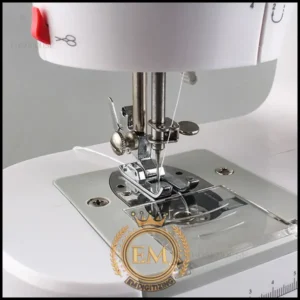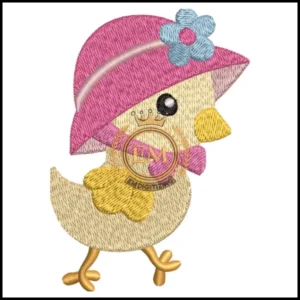Stickereien auf Nylongewebe können Ihren Projekten einen Hauch von Eleganz und Einzigartigkeit verleihen. Whether you’;Eine Nylonjacke neu verschönern oder eine Nylontasche mit Stickereien versehen, Der Einsatz einer Stickmaschine kann den Vorgang einfacher und effizienter machen.

In dieser Schritt-für-Schritt-Anleitung, Wir führen Sie mit einem durch den Prozess der Nylonstickerei Stickmaschine, Von der Auswahl der richtigen Materialien bis zur Einrichtung Ihrer Maschine für optimale Ergebnisse.
Stickerei auf Nylon: Der ultimative Leitfaden
Auswahl der richtigen Materialien und Ausrüstung zum Sticken auf Nylon:
Auswahl des geeigneten Stickgarns:
Wenn es um Stickereien auf Nylon geht, das Richtige wählen Stickgarn ist entscheidend. Nylon ist ein glatter und rutschiger Stoff, Daher wird die Verwendung eines speziell für Nylon entwickelten Fadens empfohlen.

Suchen Sie nach Polyesterfäden, da sie einen höheren Reibungswiderstand haben, Dies verhindert ein Ausfransen und Brechen während des Stickvorgangs.
Zusätzlich, Polyesterfäden bieten lebendige Farben und eine hervorragende Waschbarkeit, Daher sind sie ideal für Nylonstoffe.
Den richtigen Stabilisatortyp für Nylon verstehen:
Der Stabilisator spielt eine Schlüsselrolle für eine erfolgreiche Stickerei auf Nylon. Nylon ist ein leichter Stoff, der leicht verrutscht und sich verzieht, Also mit dem richtigen Stabilisator ist wichtig, um den Stoff beim Sticken stabil zu halten.
Für Nylon werden üblicherweise Abreißstabilisatoren verwendet, da sie vorübergehenden Halt bieten und nach dem Sticken leicht entfernt werden können.
Jedoch, if you’;Wir arbeiten mit sehr zartem oder transparentem Nylon, Sie können sich für a entscheiden wasserlöslicher Stabilisator, welches sich nach dem Sticken vollständig auflöst.
Schritt-für-Schritt-Anleitung zum Sticken auf Nylon:
Schritt # 1: Reinigen und Vorwaschen des Nylongewebes
Vor dem Sticken auf Nylon, it’;Es ist wichtig, den Stoff zu reinigen und vorzuwaschen. Dadurch wird jeglicher Schmutz beseitigt, Öle, oder Chemikalien, die vorhanden sein können, Gewährleistung einer sauberen und glatten Oberfläche zum Sticken.

Vermeiden Sie die Verwendung von Weichspülern, da sie Rückstände hinterlassen können, die die Haftung von Stabilisatoren und den Stickvorgang selbst beeinträchtigen können.
Schritt # 2: Nylon stabilisieren
Jetzt, Nylon ist tendenziell dehnbar, Dies kann dazu führen, dass sich der Stoff beim Sticken verschiebt und kräuselt. Um dies zu verhindern, you’;Sie müssen Stickstabilisatoren verwenden.
Wählen Sie ein Leichtgewicht wasserlöslicher Stabilisator und spannen Sie es zusammen mit Ihrem Stoff ein. Dies sorgt für Stabilität und Halt, So wird Ihr Stickerlebnis viel reibungsloser.
Schritt # 3: Sicheres Einspannen des Nylongewebes
Das sichere Einspannen des Nylongewebes ist entscheidend, um ein Verrutschen des Gewebes zu verhindern und sicherzustellen genaue Platzierung der Stickerei. Wählen Sie zunächst eine geeignete Rahmengröße aus, die zu Ihrem Design passt.
Legen Sie den äußeren Rahmen auf eine ebene Fläche, Legen Sie das Nylongewebe darauf, und drücken Sie den inneren Rahmen vorsichtig nach unten, Legen Sie den Stoff zwischen die beiden Reifen.

Stellen Sie sicher, dass der Stoff straff, aber nicht gedehnt ist, da übermäßige Spannung das Design verzerren kann. Ziehen Sie die Rahmenschraube fest an, um sicherzustellen, dass der Stoff sicher an Ort und Stelle gehalten wird.
Schritt # 4: Anpassen der Maschinenspannungseinstellungen für Nylon
Zur Erzielung einer optimalen Stichqualität beim Nylonsticken, it’;Es ist wichtig, die Spannungseinstellungen an Ihrer Stickmaschine anzupassen. Nylon ist normalerweise rutschiger als andere Fäden, Daher kann eine leichte Lockerung der Spannung helfen, dies zu verhindern Fadenbruch und kräuselt sich.
Jedoch, Achten Sie darauf, es nicht zu sehr zu lockern, da es zu losen Stichen kommen kann. Experimentieren Sie mit dem Spannungseinstellungen auf Stoffresten, um die perfekte Balance für Ihre Maschine und Garnkombination zu finden.
Schritt # 5: Auswahl der geeigneten Nadelgröße und des geeigneten Nadeltyps
Verwendung der rechte Nadel ist für glattes und präzises Sticken auf Nylon unerlässlich. Entscheiden Sie sich für eine scharfe Sticknadel, Am besten mit einem kleinen Auge, da dadurch das Risiko verringert wird, dass der empfindliche Stoff hängen bleibt oder beschädigt wird.

Die Nadelstärke sollte für die Dicke Ihres Nylongewebes geeignet sein. Kleinere Nadelstärken, wie zum Beispiel 70/10 oder 75/11, werden üblicherweise für leichtes Nylon verwendet, während schwereres Nylon möglicherweise größere Nadelstärken erfordert.
Erinnerung: Denken Sie daran, die Nadel regelmäßig zu wechseln, um eine optimale Leistung zu gewährleisten.
Schritt # 6: Auswählen und Digitalisieren des Stickmusters
Wenn es um das Besticken von Nylongewebe geht, it’;Es ist wichtig, dafür geeignete Designs zu wählen Art des Materials. Nylongewebe hat seine eigenen einzigartigen Eigenschaften, Entscheiden Sie sich daher für Designs, die nicht zu kompliziert oder zu dicht sind, da sie auf Nylon möglicherweise nicht gut nähen.

Once you’;Wir haben das perfekte Design gefunden, it’;Es ist Zeit, es zu digitalisieren optimale Nähte auf Nylon. Digitalisierung ist der Prozess von Konvertieren eines Designs in ein Format dass eine Stickmaschine lesen kann.
Beim Digitalisieren für Nylon, Ziehen Sie in Betracht, etwas breitere Stiche zu verwenden und die Dichte des Motivs auf zu reduzieren Falten verhindern und Verzerrung.
Schritt # 7: Stickprozess
Fügen Sie die ein Stickdatei und starten Sie den Stickvorgang, Beobachten Sie das Stoffverhalten. Nylon kann sich verschieben oder verziehen, Seien Sie also darauf vorbereitet, bei Bedarf eine Pause einzulegen und neue Anpassungen vorzunehmen. Behalten Sie die im Auge Fadenspannung während des gesamten Prozesses, um glatte Stiche zu gewährleisten.
Schritt # 8: Fertigstellen und Pflegen bestickter Nylonprojekte
Nach Abschluss Ihres bestickten Nylonprojekts, it’;Es ist wichtig, ihm den richtigen letzten Schliff zu geben. Schneiden Sie alle losen Fäden sorgfältig ab, um ein sauberes Erscheinungsbild zu gewährleisten. Befestigen Sie alle losen Enden mit einem Klecks Stoffkleber oder indem Sie sie von Hand festnähen.
Wenn es ums Waschen geht und Bügeln bestickt Nylongewebe, it’;Es empfiehlt sich, die dem Stoff beiliegenden Pflegehinweise zu befolgen.
Allgemein, it’;Am besten waschen Sie Nylon-Kleidungsstücke mit der Hand oder nutzen Sie den Schonwaschgang der Waschmaschine. Um eine Beschädigung der Stickerei zu vermeiden, Bei niedriger Temperatur bügeln oder ein Bügeltuch verwenden, um die Nähte zu schützen.
Behebung häufiger Probleme bei der Nylonstickerei:
Trotz Ihrer besten Bemühungen, Beim Sticken auf Nylon kann es dennoch zu einigen Herausforderungen kommen:
- Wenn der Faden reißt oder ausfranst, Versuchen Sie es mit einer Qualität Stickgarn und Anpassen der Spannung Ihrer Maschine. Manchmal, Auch die Verwendung eines speziell für Stickgarn entwickelten Gleitmittels kann hilfreich sein.
- Designverzerrungen oder Fehlausrichtungen können frustrierend sein, Aber es gibt Möglichkeiten, diese Probleme anzugehen. Überprüfen Sie, ob Ihr Stoff sicher eingespannt ist und Ihr Design richtig zentriert ist. Wenn Sie beim Nähen eine Verzerrung bemerken, Stoppen Sie die Maschine und nehmen Sie Anpassungen an der Spannung vor, Stabilisator, oder Design-Digitalisierung.
Endeffekt:
Erinnern, Übung macht den Meister, wenn es um das Besticken von Nylon geht. Don’;t be discouraged if your first attempts aren’;Es ist nicht einwandfrei.
Mit der Zeit, Geduld, und ein bisschen Fehlerbehebung, you’;Ich werde bald atemberaubende Stickprojekte auf Nylonstoff erstellen.
Viel Spaß beim Sticken!
EMdigitalisieren: Der Digitalisierungspartner, dem Sie vertrauen können:
EMdigitizing ist Ihr vertrauenswürdiger Partner in Stickerei digitalisieren und Vektorkunstdienste, betreut Kunden weltweit.
What’;s great about EMdigitizing is they’;Ich bin wirklich schnell und mache einen super Job. Sie können in weniger als ein kostenloses Angebot einholen 5 Protokoll. Und rate was? If you’;Ich bin ein neuer Kunde, you’;Ich werde ein riesiges bekommen 50% Rabatt auf alle ihre Dienstleistungen.
Don’;Lassen Sie sich dieses tolle Angebot nicht entgehen. Klicken Sie auf den Link, und EMdigitizing lässt Ihre Stickdesigns fantastisch aussehen. It’;Es ist eine unterhaltsame und einfache Möglichkeit, Ihre Stickprojekte noch besser zu machen!
Häufig gestellte Fragen:
Ja, Nylon kann bestickt werden, Aufgrund seiner rutschigen und hitzeempfindlichen Beschaffenheit sind jedoch spezielle Techniken und Einstellungen erforderlich.
Ja, man kann es besticken 100% Nylon, mit einem geeigneten Stabilisator, richtige Nadel, und die Maschineneinstellungen entsprechend anzupassen.
Das Besticken von Ripstop-Nylon ist möglich, Aufgrund des leichten und langlebigen Gewebes ist jedoch eine sorgfältige Handhabung unerlässlich.
Nylon kann genäht werden, Es sind jedoch scharfe Nadeln und eine entsprechende Fadenspannung erforderlich, um Kräuseln und Verlaufen zu vermeiden.
Nylon ist nicht völlig reißfest, weist jedoch eine hohe Reiß- und Reißfestigkeit auf, insbesondere in Geweben wie Ripstop-Nylon.
